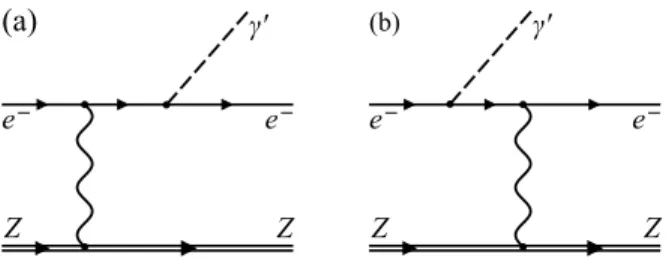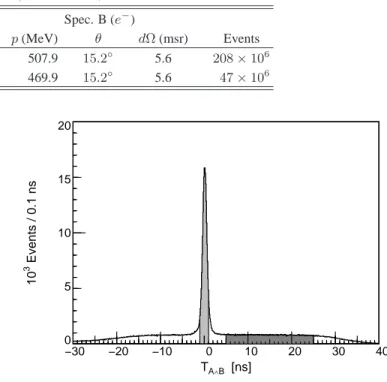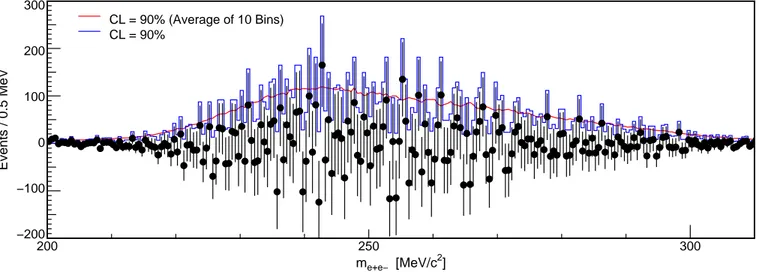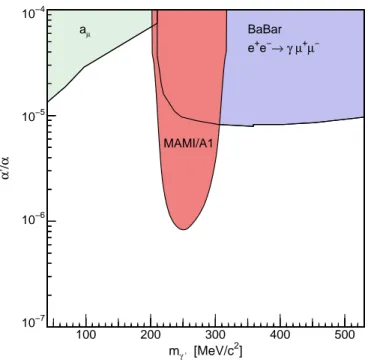arXiv:1101.4091v2 [nucl-ex] 24 Jun 2011
Search for light gauge bosons of the dark sector at MAMI
H. Merkel,1, ∗P. Achenbach,1C. Ayerbe Gayoso,1J. C. Bernauer,1, †R. B¨ohm,1D. Bosnar,2L. Debenjak,3 A. Denig,1M. O. Distler,1A. Esser,1H. Fonvieille,4I. Friˇsˇci´c,2D. G. Middleton,1U. M¨uller,1L. Nungesser,1 J. Pochodzalla,1M. Rohrbeck,1S. S´anchez Majos,1B. S. Schlimme,1M. Schoth,1S. ˇSirca,3, 5and M. Weinriefer1
(A1 Collaboration) 1
Institut f¨ur Kernphysik, Johannes Gutenberg-Universit¨at Mainz, D-55099 Mainz, Germany‡ 2
Department of Physics, University of Zagreb, HR-10002 Zagreb, Croatia 3Joˇzef Stefan Institute, SI-1000 Ljubljana, Slovenia
4
Clermont Universit´e, Universit´e Blaise Pascal, CNRS/IN2P3, LPC, BP 10448, F-63000 Clermont-Ferrand, France 5
Department of Physics, University of Ljubljana, SI-1000 Ljubljana, Slovenia (Dated: January 21, 2011)
A new exclusion limit for the electromagnetic production of a lightU (1) gauge boson γ′
decaying toe+
e− was determined by the A1 Collaboration at the Mainz Microtron. Such light gauge bosons appear in several extensions of the standard model and are also discussed as candidates for the interaction of dark matter with standard model matter. In electron scattering from a heavy nucleus, the existing limits for a narrow state coupling toe+e−
were reduced by nearly an order of magnitude in the range of the lepton pair mass of210 MeV/c2<
me+e− < 300 MeV/c 2
. This experiment demonstrates the potential of high current and high resolution fixed target experiments for the search for physics beyond the standard model.
PACS numbers: 14.70.Pw, 25.30.Rw, 95.35.+d
Introduction.— An additional U (1) interaction appears to
be natural in nearly all theoretical extensions of the standard model. Large gauge symmetries have to be broken andU (1) bosons provide the lowest-rank local symmetries. For exam-ple, in standard embedding of most variants of string theories aU (1) boson is generated by symmetry breaking. Such ad-ditionalU (1) bosons may be hidden; e.g., no standard model particles are charged under the corresponding symmetry, but their mass is allowed in the range of the standard model masses.
Recently, several experimental anomalies were discussed as possible signatures for a hidden force. A lightU (1) bo-son in the mass range below1 GeV/c2might explain e.g. the observed anomaly of the muon magnetic moment [1, 2]. Cos-mology and astrophysics provide an abundant amount of ev-idence for the existence of dark matter (for a summary, see, e.g., Ref. [3]). Several experimental hints point to aU (1) bo-son coupling to leptons as the mediator of the interaction of dark matter with standard model matter (see, e.g., Ref. [4] for a detailed discussion). For example the lively debated annual modulation signal of the DAMA-LIBRA experiment [5] could be brought into accordance with the null result of bolometric experiments if one assumes an interaction via a lightU (1) bo-son [6]. Observations of cosmic rays show a positron excess [7]. While this excess may be due to astrophysical process like quasars, this could also be a hint for the annihilation of dark matter into leptons. If the experimental evidence is inter-preted as annihilation of dark matter, the excess of positrons and no excess of antiprotons in cosmic rays hints again to a mass of theU (1) boson below 2 GeV/c2.
The interaction strength of such aU (1) boson (in the fol-lowing denoted asγ′, in the literature also denoted asA′,U , orφ) with standard model particles is governed by the mech-anism of kinetic mixing [8]. The coupling can be subsumed
by an effective coupling constantǫ and a vertex structure of a massive photon.
Bjorken et al. [9] discussed several possible experimental schemes for the search of aγ′ in the most likely mass range of a fewMeV/c2 up to a fewGeV/c2. Since the coupling is small, the cross section for coherent electro magnetic pro-duction of theγ′ boson can be enhanced by a factorZ2 by choosing a heavy nucleus as the target (see Fig. 1). The sub-sequent decay of theγ′boson to a lepton pair is the signature of the reaction.
The cross section of signal and background were estimated in Ref. [9] in the Weizs¨acker-Williams approximation. In this approximation, the cross section shows a sharp peak, in both signal and background, where nearly all the energy of the in-cident electron is transferred to the lepton pair(Ee++Ee−) = E0. Correspondingly, the pair is produced dominantly in the direction of the incident electron.
The experimental challenge is the suppression of the back-ground which is dominated by radiative pair production (Fig. 2). Radiation by the final or initial electron [Figs. 2(a) and 2(b)] has the same cross-section structure as the desired signal and is an irreducible background to this experiment.
γ' Z e− e− Z Z e− e− Z
(a)
(b) γ'FIG. 1. Electromagnetic production of theγ′
boson. The coupling of theγ′
2
TABLE I. Kinematic settings. The incident beam energy wasE0= 855 MeV, and the settings are roughly centered aroundEe++ Ee− = E0andmγ′ = 250 MeV/c
2 . Spec. A (e+
) Spec. B (e−
)
p (MeV) θ dΩ (msr) p (MeV) θ dΩ (msr) Events Set-up 1 346.3 22.8◦ 21 507.9 15.2◦ 5.6 208 × 106 Set-up 2 338.0 22.8◦ 21 469.9 15.2◦ 5.6 47 × 106 l l + Z e− − e− Z l l + Z e− − e− Z l l + Z e− − e− Z l l − Z e− + e− Z
(a)
(b) (c) (d)FIG. 2. Dominant background processes. While graphs (a) and (b) have the same structure as the signal and present an irreducible back-ground, the contributions of graphs (c) and (d) can be suppressed by the choice of kinematic setting.
Radiation with an internal lepton line [Figs. 2(c) and 2(d)] has a maximum if the internal electron line is nearly on the mass shell, i.e., if one of the leptons carries nearly all the en-ergy of the pair. This background can be reduced by choosing a kinematic setting in which the electron and positron are de-tected at equal angles and momenta.
Experiment.— The experiment took place at the
spectrom-eter setup of the A1 Collaboration at the Mainz Microtron (MAMI) (see Ref. [10] for a detailed description). An unpo-larized electron beam with a beam energy ofE0 = 855 MeV and a beam current of90 µA was incident on a tantalum foil (99.9%181Ta,Z = 73) with an area density of 81.3 mg/cm2, leading to a luminosity ofL Z2= 8.07 · 1038s−1cm−2. The beam was rastered across the target to reduce the local thermal load on the target foil.
For the detection of the electron-positron pair, two high-resolution spectrometers were used. The particles were de-tected by vertical drift chambers for tracking and scintilla-tor detecscintilla-tors for trigger and timing purpose. In addition, a threshold-gas- ˇCerenkov detector was used in each arm to dis-criminate between electrons or positrons and pions.
Table summarizes the kinematic setups used. Setup 1 was chosen to be close toEe++Ee− = E0where the cross section has a sharp peak to ensure high count rates. In addition, setup 2 was selected atEe++ Ee−= 0.9 E0during the experiment
−30 −20 −10 0 10 20 30 40 0 5 10 15 20 10 3 Events / 0.1 ns TA∧B [ns]
FIG. 3. Coincidence time distribution after particle identification by ˇ
Cerenkov detectors (set-up 1). The events of the light shaded area were used as true coincidences, while the dark shaded area was used as an estimate of the accidental coincidences.
200 250 300 0 500 1000 1500 2000 2500 3000 Events / 0.5 MeV me+e− [MeV/c 2 ]
FIG. 4. Mass distribution of the reconstructede+ -e−
pair (setup 1). The dark shaded area denotes the background due to accidental coincidences (scaled to a time window of 2 ns).
to optimize the total count rates. The angles of the spectrome-ters were set to be nearly symmetric to reduce the background by the Bethe-Heitler process [Figs. 2(c) and 2(d)]. In total, data of four days of beam time were used for the analysis. The electrons and the positrons were detected by the coincidence of the raw scintillator signals. The ˇCerenkov signals were not included in the trigger logic but recorded for off-line analysis.
3 200 250 300 −200 −100 0 100 200 300 Events / 0.5 MeV me+e− [MeV/c2] CL = 90% (Average of 10 Bins) CL = 90%
FIG. 5. Upper exclusion limits with 90% confidence level determined by the Feldman-Cousins algorithm (all data). The averaged limit is included for subjective judgement only (≈ 10% of the data points should be above this line at 90% C.L.).
Data analysis.— Only events with a positive signal in the
ˇ
Cerenkov detectors were selected with an efficiency of 98% for spectrometer A and 95% for spectrometer B [10]. Fig-ure 3 shows the coincidence time between the corresponding spectrometers after correction for the flight path of ≈ 12 m within the spectrometers for these events. A timing resolu-tion of better than 1 ns FWHM was achieved, and a cut of −1 ns < tA∧B < 1 ns was used to mark the true electron-positron pairs. Below the peak, a background due to acci-dental coincidences is present. To estimate this background, events in the coincidence side band5 ns < tA∧B < 25 ns were selected and weighted by the ratio of the timing win-dows.
For the real electron-positron pairs the invariant mass squared of the pair was determined by the four-momentum summ2
e+e− = (pe++ pe−) 2
. Figure 4 shows the resulting mass spectrum. The contribution of the accidental background is indicated by the dark shaded area.
In this figure, a possible candidate for the dark photon would appear as a peak on top of the background. The width of such a peak can only be estimated by simulation. For this, the experimental resolution of the four-vector determination of a single spectrometer was determined by the width of the lowest lines of the nuclear excitation spectrum in elastic elec-tron scattering. This single spectrometer resolution was used as input for the simulation of the experiment. A mass resolu-tion of better than0.5 MeV/c2 was determined, correspond-ing to the chosen bin width in Fig. 4.
No significant peak in the mass spectrum was observed. The corresponding upper limit was determined by the Feldman-Cousins algorithm [11]. As input for this algorithm the raw mass spectrum was used, and as a background esti-mate for each bin the mean of the three neighboring bins on either side was used. This choice of the background estimate introduces systematic errors, which have to be investigated in the case of a positive signal but only enhance statistical
fluc-0.90 0.95 1.00 0 1000 2000 3000 4000 5000 Events (Ee++Ee−)/E0
Model: e+181Ta→e’+181Ta+2e Weizsäcker−Williams •| Data
FIG. 6. Comparison of simulation with data (setup 1). As a model the coherent electro-production from a heavy nucleus was used.
tuations in the case of an upper limit. Figure 5 shows the resulting exclusion limits.
Results and Interpretation.— In order to interpret the
re-sult in terms of the effective couplingǫ of a possible dark photon candidate, a model for the production process has to be used. Unfortunately, it turns out that the Weizs¨acker-Williams-approximation used in Ref. [9] fails in this energy range by orders of magnitude, mainly since the recoil of the nucleus cannot be neglected. Taking into account the nuclear recoil, the peak at(Ee++Ee−) = E0in Ref. [9] is regularized and the cross section at this point becomes zero. In addition, the assumption of a real initial photon exactly in the direction of the electron beam introduces a peak in the angular distribu-tion, which is not present in electro production due to helicity conservation of the scattered electron.
Instead, we used as a model for theγ′production the coher-ent electro production from the tantalum nucleus, calculated
4 100 200 300 400 500 10−7 10−6 10−5 10−4 α ’/ α mγ ’ [MeV/c 2 ] aµ MAMI/A1 BaBar e+e−→γµ+µ−
FIG. 7. Exclusion limits with 90% confidence level in terms of rel-ative couplingα′/α = ǫ2
. Also shown are the previous results by BABAR [12] and foraµof the muon [2].
as the coherent sum of the graphs of Fig. 1. The charge dis-tribution of tantalum was approximated as a solid sphere. For the QED background we used the coherent sum of the graphs of Fig. 2. The corresponding cross sections were included on an event by event basis in the simulation. The simulation including this model shows excellent agreement with data, as demonstrated in Fig. 6, where the background-subtracted yields as an estimate for the QED background graphs are com-pared to the simulation of this process.
The remaining model dependence of this interpretation mainly affects the nuclear vertex, since, e.g., the possible breakup of the recoil nucleus is neglected. Since this vertex is common to both the signal and the QED background chan-nels, to further reduce the model dependence we use only the ratio of the signal to QED background of the simulation in addition to the accidental background. The ratio can be trans-lated to the effective coupling for a given mass resolutionδm by using Eq. (19) of Ref. [9]:
dσ(X → γ′Y → e+e−Y ) dσ(X → γ∗Y → e+e−Y ) = 3π 2Nf ǫ2 α mγ′ δm
and the measured event rate as an estimate for the background
channel. The number of final statesNf includes the ratio of phase space for the corresponding decays above theµ+µ− threshold.
Figure 7 shows the result of this experiment in terms of the ratio of the effective coupling to the fine structure constant α′/α = ǫ2. For clarity of the figure, the exclusion limit was averaged. Also shown are the existing limits published by BaBar [12] and the standard model prediction [2] of the muon anomalous magnetic momentaµ = gµ/2 − 1 (calculation of exclusion limits inǫ2 by [13]). The existing exclusion limit has been extended by an order of magnitude.
In this experiment, the discovery potential of the existing high luminosity electron accelerators has been demonstrated. The background conditions are well under control due to ex-cellent timing and missing mass resolution. An extensive pro-gram to cover further mass regions with similar experiments is planned at MAMI, Jefferson Lab[13], and other laboratories (for a review see Ref. [14]).
The authors thank the MAMI accelerator group for provid-ing the excellent beam quality and intensity necessary for this experiment and T. Beranek for fruitful discussions on the QED calculations. This work was supported by the Federal State of Rhineland-Palatinate and by the Deutsche Forschungsgemein-schaft with the Collaborative Research Center 443.
∗
merkel@kph.uni-mainz.de †
Present address: MIT-LNS, Cambridge, MA, USA. ‡
http://www.kph.uni-mainz.de
[1] G. W. Bennett et al., Phys. Rev. D, 73, 072003 (2006). [2] M. Pospelov, Phys. Rev., D80, 095002 (2009).
[3] K. Nakamura et al. (Particle Data Group), J. Phys., G37, 075021 (2010).
[4] N. Arkani-Hamed, D. P. Finkbeiner, T. R. Slatyer, and N. Weiner, Phys. Rev., D79, 015014 (2009).
[5] R. Bernabei et al., Eur. Phys. J., C56, 333 (2008).
[6] N. Borodatchenkova, D. Choudhury, and M. Drees, Phys. Rev. Lett., 96, 141802 (2006).
[7] O. Adriani et al., Nature, 458, 607 (2009). [8] B. Holdom, Phys. Lett., B166, 196 (1986).
[9] J. D. Bjorken, R. Essig, P. Schuster, and N. Toro, Phys. Rev., D80, 075018 (2009).
[10] K. I. Blomqvist et al., Nucl. Instrum. Meth., A403, 263 (1998). [11] G. J. Feldman and R. D. Cousins, Phys. Rev., D57, 3873 (1998). [12] B. Aubert et al., Phys. Rev. Lett., 103, 081803 (2009). [13] R. Essig, P. Schuster, N. Toro, and B. Wojtsekhowski, JHEP,
02, 009 (2011).
[14] S. Andreas and A. Ringwald, “Status of sub-GeV Hidden Particle Searches,” (2010), DESY 10-137, arXiv:1008.4519 [hep-ph].



